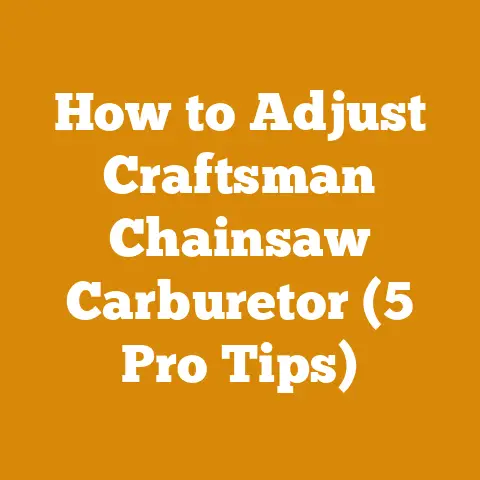What Can Kill Tree Stumps (5 Expert Methods for Clean Removal)
Have you ever been left staring at a stubborn tree stump, wondering how to reclaim your yard?
I have.
More times than I care to admit.
Those woody remnants can be a real eyesore and a tripping hazard, not to mention a breeding ground for unwanted pests.
But don’t despair!
Over the years, I’ve tackled my fair share of stumps, and I’m here to share five expert methods for clean removal.
We’ll delve into the tools, techniques, and even a little bit of chemistry, all with the goal of transforming that frustrating stump into usable space.
Understanding the Challenge: Why Stumps are so Stubborn
Before we jump into the removal methods, it’s important to understand why tree stumps are so difficult to get rid of.
A tree stump isn’t just a dead piece of wood.
It’s connected to a vast root system that can extend far beyond what you see above ground.
These roots anchor the stump firmly in place and continue to provide it with some level of sustenance, making it surprisingly resilient.
Think of it like this: a tree is a complex network, and the stump is the central hub.
Even after the tree is felled, that hub retains a significant amount of energy and structural integrity.
This is why simply trying to dig it out often proves futile.
You’ll likely encounter a tangled mess of roots that are incredibly difficult to sever.
Furthermore, the type of wood plays a crucial role.
Hardwoods like oak and maple have denser, more resistant wood than softwoods like pine or fir.
This means they’ll take longer to decompose naturally and will require more effort to remove mechanically.
And let’s not forget about the surrounding soil.
Clay soil, for example, will hold the stump more firmly than sandy soil.
Finally, the size of the stump matters.
A small stump from a sapling is obviously much easier to deal with than a massive stump from a mature tree.
So, before you start, take stock of the stump’s size, the type of wood, and the surrounding soil conditions.
This will help you choose the most effective removal method.
Key Terms and Concepts
Let’s clarify a few key terms that will come up frequently:
Green Wood vs.
Seasoned Wood: Green wood is freshly cut wood that still contains a high moisture content.
Seasoned wood, on the other hand, has been dried, reducing its moisture content.
Green wood is more difficult to split and heavier than seasoned wood.
Stumps are essentially made of green wood initially, and their slow decomposition is partly due to this high moisture content.Decomposition: The natural process of breaking down organic matter.
In the context of stumps, this involves fungi and bacteria consuming the wood.-
Potassium Nitrate (Stump Remover): A chemical compound that accelerates the decomposition process by providing nitrogen, a nutrient that fungi and bacteria need to thrive.
-
Stump Grinder: A machine specifically designed to grind down tree stumps into small chips.
Method 1: The Chemical Decomposition Approach
This method relies on accelerating the natural decomposition process using chemicals.
It’s a relatively hands-off approach, but it requires patience.
Step 1: Gather Your Supplies
- Potassium Nitrate (Stump Remover): You can find this at most garden centers or online.
Make sure to follow the manufacturer’s instructions carefully. - Drill with a long, wide drill bit (1/2 inch or larger): The size of the drill bit depends on the diameter of the stump.
- Water: To dissolve the potassium nitrate.
- Plastic Tarp or Heavy-Duty Plastic Bag: To cover the stump.
- Weight (rocks, bricks, etc.): To secure the tarp.
Step 2: Drill Holes in the Stump
Using your drill, create a series of holes in the stump.
The holes should be spaced about 4-6 inches apart and should be as deep as possible without drilling all the way through the stump.
Angle the holes slightly downwards to help retain the potassium nitrate solution.
I usually aim for a depth that’s about 80% of the stump’s height.
On larger stumps, I also drill holes around the perimeter, angled towards the center.
Step 3: Apply the Potassium Nitrate Solution
Mix the potassium nitrate with water according to the manufacturer’s instructions.
Pour the solution into the holes, filling them completely.
You may need to repeat this process several times as the stump absorbs the solution.
Step 4: Keep the Stump Moist
Cover the stump with a plastic tarp or heavy-duty plastic bag to retain moisture.
Secure the tarp with weights to prevent it from blowing away.
The goal is to create a humid environment that encourages fungal growth.
Step 5: Wait (Patiently!)
This is the most crucial step.
The decomposition process can take several months to a year, depending on the size of the stump and the type of wood.
During this time, the potassium nitrate will help break down the wood fibers, making the stump softer and more porous.
Step 6: Chop and Remove
Once the stump has become sufficiently soft, you can start chopping it apart with an axe or mattock.
The softened wood should be much easier to remove than solid wood.
You can also use a shovel to dig around the stump and sever any remaining roots.
Personal Story: I once used this method on a large oak stump in my backyard.
It took almost a year for the stump to decompose significantly, but the result was worth the wait.
I was able to chop it apart with relative ease and fill the hole with topsoil.
Benefits:
- Relatively low effort.
- No heavy machinery required.
- Environmentally friendly (compared to some other methods).
Drawbacks:
- Very slow process.
- May not be effective on all types of wood.
- Requires regular monitoring to ensure the stump remains moist.
Cost: The cost is relatively low, primarily involving the purchase of potassium nitrate (typically $20-$50, depending on the quantity) and the cost of a drill bit, if you don’t already own one.
Skill Level: Beginner.
Method 2: Epsom Salt Method
Similar to the potassium nitrate method, this approach uses Epsom salt (magnesium sulfate) to dry out the wood and make it more susceptible to decomposition.
Step 1: Gather Supplies
- Epsom Salt: Available at most pharmacies and garden centers.
- Drill with a long, wide drill bit (1/2 inch or larger).
- Water: To dissolve the Epsom salt.
- Bucket or container for mixing.
Step 2: Drill Holes in the Stump
Follow the same procedure as in the potassium nitrate method.
Drill holes that are about 4-6 inches apart and as deep as possible, angling them slightly downwards.
Step 3: Apply the Epsom Salt Solution
Mix a concentrated solution of Epsom salt and water in a bucket.
The ratio should be approximately 1 pound of Epsom salt per gallon of water.
Pour the solution into the holes, filling them completely.
Step 4: Repeat Application Regularly
Unlike the potassium nitrate method, the Epsom salt method requires repeated applications.
You’ll need to pour the solution into the holes every few weeks, especially during dry periods.
This helps to maintain a high concentration of Epsom salt in the wood, which will dry it out and inhibit fungal growth.
Paradoxically, drying it out encourages cracking, which then exposes more surface area for fungal attack.
Step 5: Wait and Chop
The decomposition process with Epsom salt can take several months, similar to the potassium nitrate method.
Once the stump has become sufficiently soft and brittle, you can start chopping it apart with an axe or mattock.
Personal Story: I tried this method on a smaller pine stump.
It seemed to work faster than the potassium nitrate method, possibly because pine is a softwood.
The stump became noticeably drier and cracked within a few months.
Benefits:
- Relatively inexpensive.
- Epsom salt is readily available.
- Less harsh than some chemical alternatives.
Drawbacks:
- Requires more frequent applications.
- May not be as effective on large, dense stumps.
- Still a relatively slow process.
Cost: Epsom salt is quite affordable, usually costing around $10-$20 for a large bag.
Skill Level: Beginner.
Method 3: The Manual Labor Approach (Digging and Chopping)
This is the most physically demanding method, but it’s also the most direct.
It involves digging around the stump, severing the roots, and then removing the stump entirely.
Step 1: Gather Your Supplies
- Shovel: A sturdy shovel is essential for digging around the stump.
- Axe or Mattock: For chopping through roots.
A mattock is particularly useful for breaking up hard soil. - Saw (Hand Saw or Reciprocating Saw): To cut through larger roots.
- Loppers or Pruning Shears: For cutting smaller roots.
- Work Gloves: To protect your hands.
- Eye Protection: To protect your eyes from flying debris.
- Optional: Chainsaw: For cutting larger roots (use with extreme caution and proper safety gear).
Step 2: Dig Around the Stump
Start by digging a wide circle around the stump, exposing the major roots.
The diameter of the circle will depend on the size of the stump and the extent of the root system.
I typically start with a circle that’s at least twice the diameter of the stump.
Step 3: Sever the Roots
Once you’ve exposed the roots, use your axe, mattock, saw, or loppers to sever them.
Start with the larger roots and work your way down to the smaller ones.
Be prepared to encounter some resistance, especially with larger roots.
A reciprocating saw with a metal-cutting blade can be very helpful for cutting through stubborn roots.
If using a chainsaw, exercise extreme caution.
Chainsaws can easily kick back or get stuck in the ground.
Always wear appropriate safety gear, including eye protection, hearing protection, and sturdy gloves.
Step 4: Wiggle and Lift
As you sever the roots, try wiggling the stump to loosen it.
Once you’ve severed most of the major roots, you should be able to lift the stump out of the ground.
If the stump is too heavy to lift by yourself, you may need to enlist the help of a friend or use a lever (a long piece of wood or metal) to pry it out.
Step 5: Fill the Hole
Once you’ve removed the stump, fill the hole with topsoil and compact it.
You may need to add more soil over time as it settles.
Personal Story: I used this method on a smaller apple tree stump.
It was hard work, but I felt a great sense of accomplishment when I finally pulled the stump out of the ground.
I used a combination of a shovel, axe, and reciprocating saw.
Benefits:
- Immediate results.
- No chemicals required.
- Good exercise!
Drawbacks:
- Physically demanding.
- Can be time-consuming.
- May require specialized tools.
Cost: The cost depends on the tools you already own.
A good shovel and axe are essential, and a reciprocating saw can be a worthwhile investment.
Expect to spend between $50 and $200 on tools, depending on your needs.
Skill Level: Intermediate. Requires some physical strength and experience using hand tools.
Method 4: The Stump Grinder Approach
This method involves using a specialized machine called a stump grinder to grind the stump down into small chips.
It’s a fast and effective method, but it requires access to a stump grinder.
Step 1: Rent or Hire a Stump Grinder
You can rent a stump grinder from most equipment rental companies.
Alternatively, you can hire a professional tree service to grind the stump for you.
Renting a stump grinder typically costs between $100 and $300 per day, depending on the size and power of the machine.
Hiring a professional can cost anywhere from $100 to $500 or more, depending on the size of the stump and the complexity of the job.
Step 2: Prepare the Area
Clear the area around the stump of any rocks, debris, or other obstacles.
This will help to prevent damage to the stump grinder and ensure a smooth grinding process.
I also recommend removing any grass or vegetation within a few feet of the stump.
Step 3: Position the Stump Grinder
Position the stump grinder so that the grinding wheel is directly over the stump.
Most stump grinders have wheels or tracks that allow you to move them easily.
Step 4: Start Grinding
Start the stump grinder and slowly lower the grinding wheel onto the stump.
Move the grinding wheel back and forth across the stump, grinding it down in layers.
Be careful not to apply too much pressure, as this can damage the machine.
Step 5: Grind Below Ground Level
Continue grinding until the stump is below ground level.
The depth to which you need to grind will depend on your intended use for the area.
If you plan to plant grass or other vegetation, you’ll need to grind the stump down at least 6 inches below the surface.
Step 6: Fill the Hole
Once you’ve finished grinding, fill the hole with the wood chips and topsoil.
Compact the soil and add more as needed.
Personal Story: I rented a stump grinder to remove a large maple stump in my front yard.
It was a powerful machine, and it made quick work of the stump.
However, it was also quite noisy and generated a lot of dust.
Benefits:
- Fast and efficient.
- Can remove even large stumps quickly.
- Relatively easy to operate (with proper instruction).
Drawbacks:
- Requires access to a stump grinder (rental or professional service).
- Can be expensive.
- Noisy and dusty.
Cost: Rental costs range from $100 to $300 per day.
Professional services can cost $100 to $500 or more.
Skill Level: Intermediate.
Requires some mechanical aptitude and the ability to operate heavy machinery safely.
Method 5: Burning the Stump
This method involves burning the stump down to the ground.
It’s a relatively simple method, but it’s important to follow all safety precautions and local regulations.
Burning stumps may be restricted or prohibited in some areas.
Step 1: Check Local Regulations
Before you attempt to burn a stump, check with your local fire department or municipality to ensure that it’s legal to do so.
Many areas have restrictions on open burning, especially during dry periods.
Step 2: Prepare the Stump
Drill several large holes in the stump, similar to the chemical decomposition method.
This will help to create airflow and allow the fire to burn more efficiently.
Step 3: Build a Fire
Build a fire on top of the stump, using dry wood and kindling.
Start small and gradually add more fuel as the fire grows.
Step 4: Monitor the Fire
Monitor the fire closely and keep it contained.
Have a water source (garden hose or buckets of water) nearby in case the fire spreads.
Never leave the fire unattended.
Step 5: Let it Burn
Allow the fire to burn until the stump is completely consumed.
This can take several hours or even days, depending on the size of the stump.
Step 6: Extinguish the Embers
Once the stump has burned down, extinguish any remaining embers with water.
Make sure that the area is completely cool before leaving it unattended.
Personal Story: I’ve only used this method once, on a small pine stump in a remote area where burning was permitted.
It was a slow process, but it was satisfying to watch the stump gradually disappear.
Benefits:
- Simple and inexpensive.
- No heavy machinery required.
- Can be a good way to dispose of unwanted wood.
Drawbacks:
- May be restricted or prohibited in some areas.
- Requires constant monitoring.
- Can be a fire hazard.
- Slow process.
- Produces smoke and ash.
Cost: The cost is minimal, primarily involving the cost of firewood or other fuel.
Skill Level: Beginner. Requires caution and adherence to safety regulations.
Safety Considerations for All Methods
Regardless of the method you choose, safety should always be your top priority.
Here are some general safety tips:
- Wear appropriate safety gear: This includes work gloves, eye protection, hearing protection (especially when using power tools), and sturdy footwear.
- Be aware of your surroundings: Clear the area around the stump of any obstacles and be mindful of overhead power lines.
- Use tools and equipment properly: Read and follow the manufacturer’s instructions for all tools and equipment.
- Never work alone: Have someone nearby in case of an emergency.
- Be careful when using chemicals: Follow the manufacturer’s instructions carefully and wear appropriate protective gear.
- Be aware of fire hazards: If you’re burning a stump, keep a water source nearby and never leave the fire unattended.
- Call before you dig: Before digging, contact your local utility companies to locate any underground utilities.
Strategic Considerations: Choosing the Right Method
The best method for removing a tree stump depends on several factors, including:
- Size of the stump: Larger stumps will require more powerful methods, such as stump grinding or burning.
- Type of wood: Hardwoods are more difficult to remove than softwoods.
- Location of the stump: Stumps in confined spaces may be difficult to access with large machinery.
- Your budget: Some methods are more expensive than others.
- Your physical abilities: Manual labor methods require a certain level of physical fitness.
- Local regulations: Burning may be restricted or prohibited in some areas.
- Time Constraints: Some methods take significantly longer than others.
For small to medium-sized stumps in accessible locations, the manual labor approach or the chemical decomposition method may be the best option.
For larger stumps or stumps in difficult locations, stump grinding or burning may be more appropriate.
Case Study: Removing a Large Oak Stump
I once helped a friend remove a large oak stump from his backyard.
The stump was about 3 feet in diameter and was located near a fence.
We considered several options, including stump grinding and chemical decomposition, but ultimately decided to use a combination of methods.
First, we rented a stump grinder to grind down the majority of the stump.
This allowed us to remove the bulk of the wood quickly and efficiently.
However, because the stump was located near a fence, we couldn’t grind it down completely.
Next, we used the manual labor approach to remove the remaining portion of the stump.
We dug around the stump, severed the roots, and then used a lever to pry it out of the ground.
This was hard work, but it allowed us to remove the stump without damaging the fence.
Finally, we filled the hole with topsoil and planted grass.
The entire process took about two days, but the result was a beautiful, stump-free backyard.
Next Steps: Getting Started
Now that you have a better understanding of the different methods for removing tree stumps, it’s time to get started!
Here are some practical next steps:
- Assess the stump: Determine the size, type of wood, and location of the stump.
- Choose a method: Select the method that best suits your needs and abilities.
- Gather your supplies: Collect the necessary tools and materials.
- Follow the instructions: Follow the step-by-step instructions for your chosen method.
- Be patient and persistent: Stump removal can be a challenging process, so don’t get discouraged if it takes longer than you expected.
- Stay safe: Always prioritize safety and follow all safety precautions.
Removing a tree stump can be a rewarding experience.
Not only will you reclaim your yard, but you’ll also gain a sense of accomplishment.
So, grab your tools, put on your gloves, and get ready to tackle that stubborn stump!






